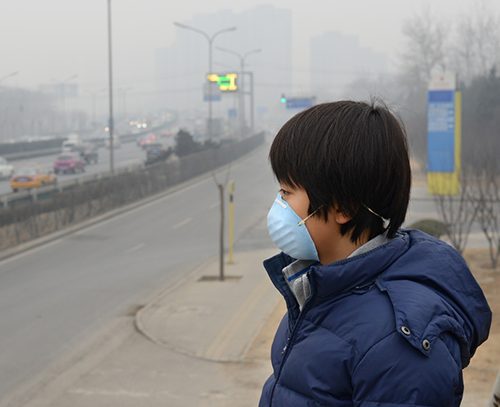
How Urban Life and Air Pollution Heighten Stroke Risk
A stroke, at its core, is a severe medical event that occurs when there is a disruption in the blood flow to the brain. This interruption deprives the brain cells of the oxygen and nutrients they need to function properly. As a consequence, brain cells begin to die, leading to potentially devastating consequences for the individual. These consequences can manifest in various ways, ranging from the loss of motor functions, making even simple movements difficult, to speech impairment, affecting communication, and cognitive deficits, which can impact memory, thinking, and decision-making abilities.
The two main types of strokes are ischemic strokes and hemorrhagic strokes. Ischemic strokes, accounting for the majority of cases, happen when a blood vessel supplying the brain becomes blocked, often due to a blood clot. Hemorrhagic strokes, on the other hand, occur when a weakened blood vessel in the brain bursts and causes bleeding. Both types of strokes can result in similar outcomes due to the disruption of blood flow and subsequent damage to brain tissue.
Understanding the nature of a stroke is crucial in addressing its risk factors and potential prevention. Recognizing the signs of a stroke and seeking immediate medical attention can make a significant difference in minimizing its impact and maximizing chances of recovery. By understanding the intricate workings of this condition, we can work towards creating environments and lifestyles that reduce the incidence of strokes and provide better support for those affected by them.
Urbanization and Its Impact on Health
The Urban Lifestyle

The urban lifestyle is a dynamic and fast-paced way of living that characterizes modern cities around the world. It encompasses a multitude of facets that shape daily routines and interactions within urban environments. One of the defining features of urban living is the constant activity and energy that permeates through bustling streets and crowded public spaces. From the early morning rush to work, to the vibrant nightlife, cities are hubs of ceaseless motion and activity. This frenetic pace often fosters a culture of productivity and ambition, driving individuals to pursue their goals with determination and vigor.
However, the urban lifestyle is not without its challenges. The demands of city living can lead to high levels of stress and pressure. Long work hours, competitive professional environments, and the constant need to keep up with the fast pace of urban life can take a toll on mental and physical well-being. Additionally, the convenience and accessibility of modern urban amenities can sometimes lead to unhealthy habits, such as a reliance on processed foods or a sedentary lifestyle. It becomes crucial for individuals in urban settings to be mindful of their well-being and seek ways to strike a balance between the demands of the city and their own health.
Despite its challenges, the urban lifestyle also offers a wealth of opportunities and experiences. Cities are melting pots of culture, diversity, and innovation. They provide access to a wide range of educational, professional, and recreational resources. The availability of cultural events, museums, theaters, and a vibrant social scene contribute to a rich and fulfilling urban experience. The urban lifestyle, with all its complexities, plays a significant role in shaping the identities and aspirations of millions of individuals who call cities their home.
Sedentary Habits and Stress
In the fast-paced urban landscape, sedentary habits have become increasingly prevalent, contributing to a host of health concerns. Many individuals find themselves spending prolonged hours in front of screens, whether for work or leisure, often leading to a significant decrease in physical activity. This lack of movement not only affects physical health but also takes a toll on mental well-being. Prolonged periods of inactivity can lead to muscle stiffness, reduced flexibility, and even weight gain. Moreover, the sedentary lifestyle can have detrimental effects on mental health, as it is closely linked with increased stress levels.

Stress is a common companion in urban environments, where the demands of work, social obligations, and the fast-paced nature of city life can create a pressure-cooker environment. Sedentary habits exacerbate this stress by limiting opportunities for physical release. Engaging in regular physical activity is a well-documented stress-buster, as it triggers the release of endorphins, the body’s natural mood lifters. When individuals are sedentary for extended periods, this essential mechanism for stress relief is stifled, potentially leading to higher levels of anxiety and tension.
Furthermore, the sedentary lifestyle can have a profound impact on the body’s overall functioning, influencing vital systems like metabolism and cardiovascular health. Sitting for prolonged periods can lead to reduced calorie expenditure and a slower metabolic rate, which can contribute to weight gain and related health issues. Additionally, studies have shown a clear link between extended periods of sitting and increased risk of cardiovascular problems, including heart disease. These health concerns, combined with the heightened stress levels associated with sedentary habits, underscore the importance of incorporating regular physical activity into the urban lifestyle.
Air Pollution: The Silent Culprit
Particulate Matter and Stroke
Particulate matter, often abbreviated as PM, refers to tiny particles suspended in the air, consisting of a mixture of solid particles and liquid droplets. These minuscule particles can vary in size, with some so small that they can be inhaled deep into the lungs. In urban environments, particulate matter is a common component of air pollution, originating from various sources such as industrial emissions, vehicular exhaust, and natural processes like dust storms. The concerning aspect of particulate matter lies in its potential to adversely affect human health, particularly in relation to cardiovascular conditions like stroke.

Scientific research has established a significant link between exposure to high levels of particulate matter and an increased risk of stroke. When inhaled, these fine particles can penetrate deep into the respiratory system, leading to inflammation and oxidative stress within the body. Over time, this can contribute to the development or exacerbation of cardiovascular diseases, including atherosclerosis, hypertension, and ultimately, stroke. The particulate matter can also lead to the formation of blood clots, further elevating the risk of stroke.
It’s important to note that the risk of stroke associated with particulate matter is not confined to any particular age group or demographic. Individuals of all ages can be affected, although those with pre-existing health conditions or compromised immune systems may be more vulnerable. The insidious nature of particulate matter lies in its pervasive presence in urban environments, making it a widespread public health concern. This underscores the urgent need for comprehensive strategies to mitigate air pollution and protect the well-being of urban populations.
NO2 and Its Effects on Cardiovascular Health
Nitrogen dioxide (NO2) is a highly reactive gas and a prominent component of air pollution in urban areas. It primarily stems from combustion processes, such as those occurring in vehicles and industrial facilities. When inhaled, NO2 can have detrimental effects on respiratory health, but its impact extends beyond the lungs to encompass the cardiovascular system. Studies have revealed a strong association between exposure to elevated levels of NO2 and an increased risk of cardiovascular diseases, including heart attacks and strokes.
One of the key mechanisms through which NO2 affects cardiovascular health is by promoting inflammation and oxidative stress within the body. This reactive gas can stimulate the production of inflammatory markers and free radicals, which can damage blood vessel walls and impair their function. Over time, this can lead to the development of atherosclerosis, a condition characterized by the narrowing and hardening of arteries. Atherosclerosis is a critical precursor to heart disease and stroke, as it impedes the flow of blood and increases the likelihood of blood clots forming.
Furthermore, NO2 exposure can contribute to the progression of existing cardiovascular conditions, particularly in individuals with pre-existing heart problems. It can exacerbate symptoms and increase the frequency of cardiovascular events. Additionally, NO2 can heighten blood pressure levels, placing additional strain on the heart. This can be especially problematic for individuals with hypertension, as it raises the risk of heart attacks and strokes. The pervasive presence of NO2 in urban environments emphasizes the urgency of implementing measures to reduce air pollution and protect the cardiovascular health of urban populations.
The Alarming Connection: Studies and Findings
Research on Stroke Incidents in Urban Areas
Extensive research has delved into the prevalence and patterns of stroke incidents within urban environments. Studies consistently highlight a notable disparity in stroke occurrence between urban and rural areas, with urban centers often exhibiting higher rates. This discrepancy can be attributed to a complex interplay of various factors intrinsic to city life. Lifestyle choices, including dietary habits and levels of physical activity, play a significant role. Urbanites are more susceptible to sedentary routines and may have limited access to green spaces, which are crucial for physical well-being.
Additionally, the stressors associated with urban living contribute substantially to the elevated risk of strokes. High-pressure work environments, long commutes, and the relentless pace of city life can lead to heightened stress levels, which are known to be a significant risk factor for cardiovascular events, including strokes. Moreover, access to healthcare and timely intervention can be both a boon and a challenge in urban areas. While cities often boast well-equipped medical facilities, the sheer volume of residents can sometimes lead to longer waiting times and delayed care. Understanding these nuances is crucial in formulating targeted interventions to reduce stroke incidents in urban environments and enhance the overall health of city dwellers.
Correlation Between Air Quality and Stroke Risk
A compelling body of research has firmly established the profound correlation between air quality and the risk of stroke. Urban environments, characterized by higher levels of air pollution, exhibit a particularly pronounced association. Particulate matter and nitrogen dioxide, prevalent pollutants in cities, have been identified as key culprits. Fine particulate matter can infiltrate deep into the respiratory system, triggering inflammation and oxidative stress that can contribute to cardiovascular conditions, including stroke. Similarly, nitrogen dioxide, stemming primarily from vehicular emissions, is notorious for its impact on both respiratory and cardiovascular health. Elevated levels of these pollutants in the air significantly heighten the risk of stroke, underscoring the urgent need for comprehensive air quality management.
The correlation between air quality and stroke risk extends beyond direct pollutant exposure. Poor air quality exacerbates existing health conditions, amplifying the vulnerability of individuals to stroke. Those with pre-existing cardiovascular issues, such as hypertension or a history of heart disease, face heightened risks in environments with compromised air quality. Furthermore, the interplay between air pollution and other lifestyle factors, such as diet and physical activity, creates a complex web of influences on stroke incidence. Recognizing this intricate relationship is paramount in implementing targeted interventions that mitigate the impact of air pollution on stroke risk, particularly in densely populated urban areas.
Vulnerable Demographics: Who’s at Higher Risk?
Age and Susceptibility
Age stands as a pivotal factor in determining susceptibility to stroke. The risk of experiencing a stroke significantly escalates with advancing years. This phenomenon can be attributed to various physiological changes that occur over time, including the gradual buildup of plaque within blood vessels, a condition known as atherosclerosis.
Additionally, the weakening of blood vessel walls and diminished elasticity contribute to the heightened vulnerability among older individuals. The aging process also brings about an increased prevalence of risk factors such as hypertension and diabetes, further amplifying the likelihood of a stroke occurrence. As such, understanding the correlation between age and stroke susceptibility is essential in formulating targeted prevention strategies and ensuring the well-being of aging populations, particularly in urban environments where the risk is often compounded by other factors like air pollution and sedentary lifestyles.
Pre-existing Health Conditions
Individuals with pre-existing health conditions are at a heightened risk of experiencing a stroke, particularly in urban environments. Conditions such as hypertension, diabetes, and cardiovascular diseases significantly amplify susceptibility. Hypertension, in particular, exerts substantial pressure on blood vessels, increasing the likelihood of blockages and ruptures that can lead to strokes.
Diabetes, on the other hand, can impair blood vessel function and lead to the accumulation of fatty deposits, further compromising cardiovascular health. Moreover, individuals with a history of heart disease are already navigating a terrain of heightened vulnerability, making them more predisposed to stroke. Recognizing the impact of pre-existing health conditions is pivotal in urban healthcare strategies, emphasizing the importance of targeted interventions and heightened vigilance for those with underlying health concerns.
How Does Air Pollution Trigger Strokes?
Inflammatory Response
The inflammatory response plays a pivotal role in the development of strokes, particularly in urban environments where factors like air pollution can heighten inflammation levels. When the body detects harmful stimuli, it initiates an inflammatory cascade as a protective mechanism. However, chronic exposure to pollutants like particulate matter and nitrogen dioxide can lead to a sustained and excessive inflammatory state. In turn, this can trigger a series of events within the cardiovascular system, including the formation of arterial plaques and the destabilization of existing ones. This heightened inflammation not only increases the risk of strokes but also exacerbates the severity of the event, underlining the critical importance of mitigating inflammatory triggers in urban settings to safeguard cardiovascular health.
Disruption of Blood Flow
A critical element in understanding stroke risk in urban environments is the potential for disruption in blood flow, often exacerbated by factors like air pollution and sedentary lifestyles. When blood flow to the brain is impeded, brain cells are deprived of oxygen and nutrients, leading to their rapid deterioration. This can result in a stroke, with the severity depending on the extent and duration of the blockage. In urban settings, where sedentary habits and exposure to pollutants are prevalent, the risk of blood flow disruption is amplified. Addressing this aspect is crucial in developing strategies to reduce stroke incidence in cities and promoting healthier lifestyles that support robust cardiovascular health.
Mitigating Stroke Risk in Urban Environments
Promoting Green Spaces
In urban environments, the cultivation of green spaces emerges as a vital strategy in mitigating stroke risk. These verdant areas serve as crucial sanctuaries amid the concrete jungle, offering a multitude of health benefits. Access to parks, gardens, and natural landscapes encourages physical activity, providing urban dwellers with opportunities to engage in exercise and alleviate the sedentary habits often associated with city living.
Moreover, green spaces act as natural air filters, improving air quality by absorbing pollutants and releasing oxygen. This not only enhances respiratory health but also directly contributes to reducing the risk of strokes linked to poor air quality. By prioritizing the creation and preservation of green spaces, cities can foster environments that support cardiovascular health and overall well-being for their residents.
Encouraging Active Transportation
Promoting active transportation methods, such as walking and cycling, is a pivotal step in mitigating stroke risk in urban areas. These sustainable modes of travel not only reduce reliance on pollutant-emitting vehicles but also foster regular physical activity. By creating pedestrian-friendly infrastructure, cities can incentivize residents to incorporate exercise into their daily routines. This not only bolsters cardiovascular health but also addresses sedentary habits that can contribute to stroke risk. Encouraging active transportation not only supports cleaner air and reduced emissions but also serves as a powerful tool in cultivating healthier, more resilient urban communities.
Advocating for Clean Air Policies
Championing clean air policies stands as a fundamental pillar in the fight against stroke risk in urban environments. Implementing stringent regulations on emissions from industries, vehicles, and other sources of pollution is essential in curbing the levels of harmful particulate matter and gases in the air. Additionally, it encourages the adoption of cleaner technologies and practices, ultimately leading to improved air quality. These policies not only safeguard respiratory health but also directly address the cardiovascular risks associated with exposure to pollutants like nitrogen dioxide. By advocating for and enforcing robust clean air measures, cities can significantly reduce the incidence of strokes and enhance the overall well-being of their inhabitants.
Personal Measures: Safeguarding Your Health
Monitoring Air Quality
Vigilant monitoring of air quality is a crucial component in the battle against stroke risk in urban environments. Utilizing advanced technologies to track levels of particulate matter, nitrogen dioxide, and other pollutants allows for timely interventions and targeted strategies. This real-time data empowers both individuals and authorities to make informed decisions regarding outdoor activities and exposure to potentially hazardous air conditions. By staying vigilant about air quality, cities can take proactive measures to mitigate the impact of pollution on cardiovascular health, ultimately reducing the incidence of strokes and creating safer, healthier urban environments.
Adopting Healthy Habits
In the urban landscape, the cultivation of healthy habits plays a pivotal role in mitigating stroke risk. This encompasses a range of lifestyle choices, from maintaining a balanced diet rich in fruits, vegetables, and whole grains, to engaging in regular physical activity. Avoiding smoking and limiting alcohol consumption are also crucial steps in promoting cardiovascular health. Moreover, prioritizing sufficient sleep and managing stress levels are integral components of a healthy urban lifestyle. By embracing these habits, individuals can fortify their resilience against stroke risk and contribute to the overall well-being of urban communities.
The Role of Technology: Air Quality Monitors
Air quality monitors equipped with cutting-edge technology are pivotal tools in the battle against stroke risk in urban environments. These devices provide real-time data on pollutant levels, offering valuable insights into the immediate environmental conditions. By utilizing advanced sensors and analytical capabilities, air quality monitors can track fine particulate matter, nitrogen dioxide, and other harmful substances with precision. This information empowers individuals, local authorities, and health organizations to make informed decisions about outdoor activities and implement targeted interventions to safeguard public health. Embracing the capabilities of air quality monitors is a significant stride towards creating healthier urban environments, ultimately reducing the incidence of strokes and improving the well-being of city residents.
Conclusion:
In the bustling realms of urban life, the intricate dance between our lifestyles and the environment takes center stage in the context of stroke risk. The amalgamation of sedentary habits, high-stress urban living, and susceptibility due to age and pre-existing health conditions sets the stage for a concerning narrative. Particulate matter and nitrogen dioxide, the subtle culprits in this tale, infiltrate our daily existence, insidiously heightening the risk of strokes.
Through inflammation and the disruption of blood flow, they pave the way for this critical health event. However, within the intricate labyrinth of urban challenges lie beacons of hope. Initiatives like green spaces, active transportation, and clean air policies wield the power to reshape this narrative. They stand as robust sentinels, guarding against the impending threat, and offering a blueprint for urban landscapes that prioritize the well-being of their inhabitants. By embracing these interventions and harnessing the potential of technology in monitoring our surroundings, we embark on a journey towards healthier, more resilient cities, where the risk of strokes is mitigated, and the vitality of urban life is preserved.
Related Link















